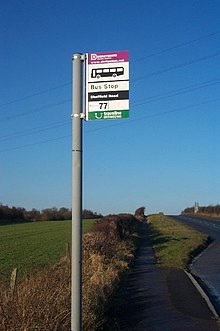|
NaPTAN
 The National Public Transport Access Node (NaPTAN) database is a UK nationwide system for uniquely identifying all the points of access to public transport in the UK. The dataset is closely associated with the National Public Transport Gazetteer. Every UK railway station, coach terminus, airport, ferry terminal, bus stop, taxi rank or other place where public transport can be joined or left is allocated a unique NaPTAN identifier. The relationship of the stop to a City, Town, Village or other locality can be indicated through an association with elements of the National Public Transport Gazetteer. There is a CEN standardisation initiative, Identification of Fixed Objects In Public Transport ('IFOPT'), to develop NaPTAN concepts into a European standard for stop identification as an extension to Transmodel, the European standard for Public Transport information. Purpose of NaPTANThe ability to identify and locate stops in relation to topography, both consistently and economically, is fundamental to modern computer based systems that provide passenger information and manage public transport networks. Stop data is needed by journey planners, scheduling systems, real-time systems, for transport planning, performance monitoring, and for many other purposes. Digitalising a nation's public transport stops is an essential step in creating a national information infrastructure. In the UK NaPTAN enabled the creation of the Transport Direct Portal, a UK nationwide system for multi-modal journey planning. NaPTAN also underpins TransXChange, the UK standard for bus schedules, which is used for the Electronic Registration of Bus Services.[citation needed] NaPTAN ComponentsNaPTAN comprises several distinct elements
NaPTAN identifiers are designed to be used within the UK's Digital National Framework a system of unique persistent reference for shareable information resources of all types managed by the Ordnance Survey. NaPTAN includes on a related standard - the UK National Public Transport Gazetteer. The NaPTAN DatabaseThe National Public Transport Access Node dataset has information on all UK public transport stops. Stops are submitted by PTEs to a central authority which consolidates the stops and distributes them back to users. There are currently 380,000 active stop points. NaPTAN is maintained by the Department of Transport. The NaPTAN XML SchemaNaPTAN data is described by a NaPTAN XML Schema. This can be used to describe NaPTAN data when exchanging it between systems as XML documents. It is versioned so that different generations of data can be managed. See http://www.dft.gov.uk/naptan/schema/2.4/NaPTAN.xsd NaPTAN Conceptual ModelThe NPTG & NaPTAN data conform to a family of consistent, interlocking data models. The models are described in the NPTG & NaPTAN Schema Guide in UML notation. NaPTAN StopsNaPTAN Stop NumberingNaPTAN identifiers are a systematic way of identifying of all UK points of access to public transport or "Stop points").
NaPTAN Stop DescriptorsNaPTAN stop points have a number of text descriptor elements associated with them: not just a name, but also additional labels and distinguishing identifiers that will help users to recognise them. These elements can be combined in different ways to provide presentations of names useful for many different contexts, for example on maps, stop finders, timetables etc., and on mobile devices
The Purpose of these descriptors is to create an iterative level of detail i.e. Country - County - Locality - Street - Name - Identifier. All of this information should be included but it is up to the user of the data to decide how much data is relevant for the task in hand. Stop LocationsEvery NaPTAN point includes geospatial coordinates specified in Ordnance Survey National Grid format, and as WGS84 latitude and longitude pairs where these are provided by local authorities. This allows NaPTAN points to be projected on maps and to be associated with other information layers. National Public Transport GazetteerThe National Public Transport Gazetteer is closely associated with the NaPTAN dataset and contains details of every City, Town, Village, suburb in Great Britain (i.e., UK but not including Northern Ireland). This dataset is based on usage of names, rather than legal definitions and so includes local informal names for places as well as their official names. See alsoReferences
External links |
Portal di Ensiklopedia Dunia